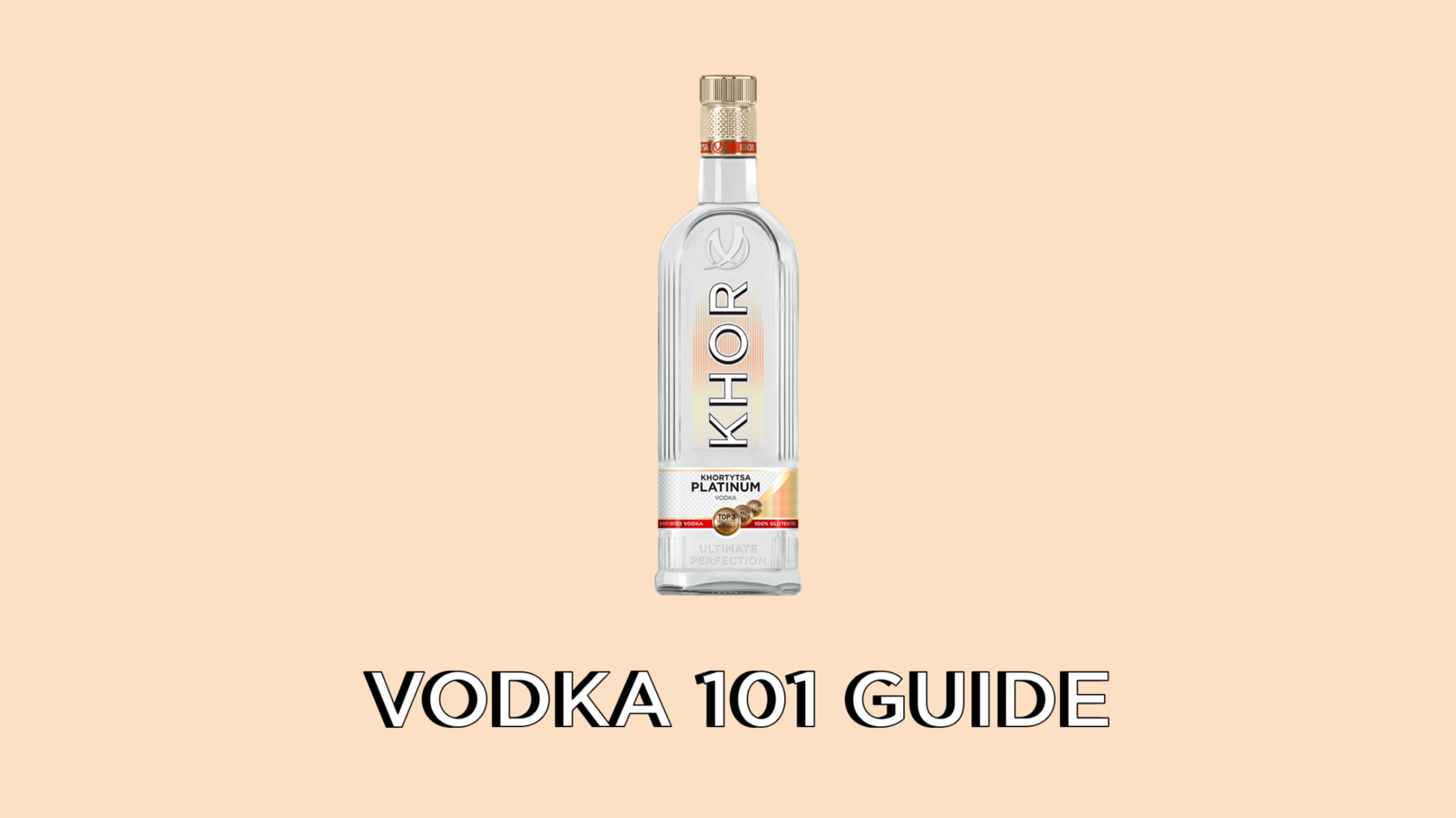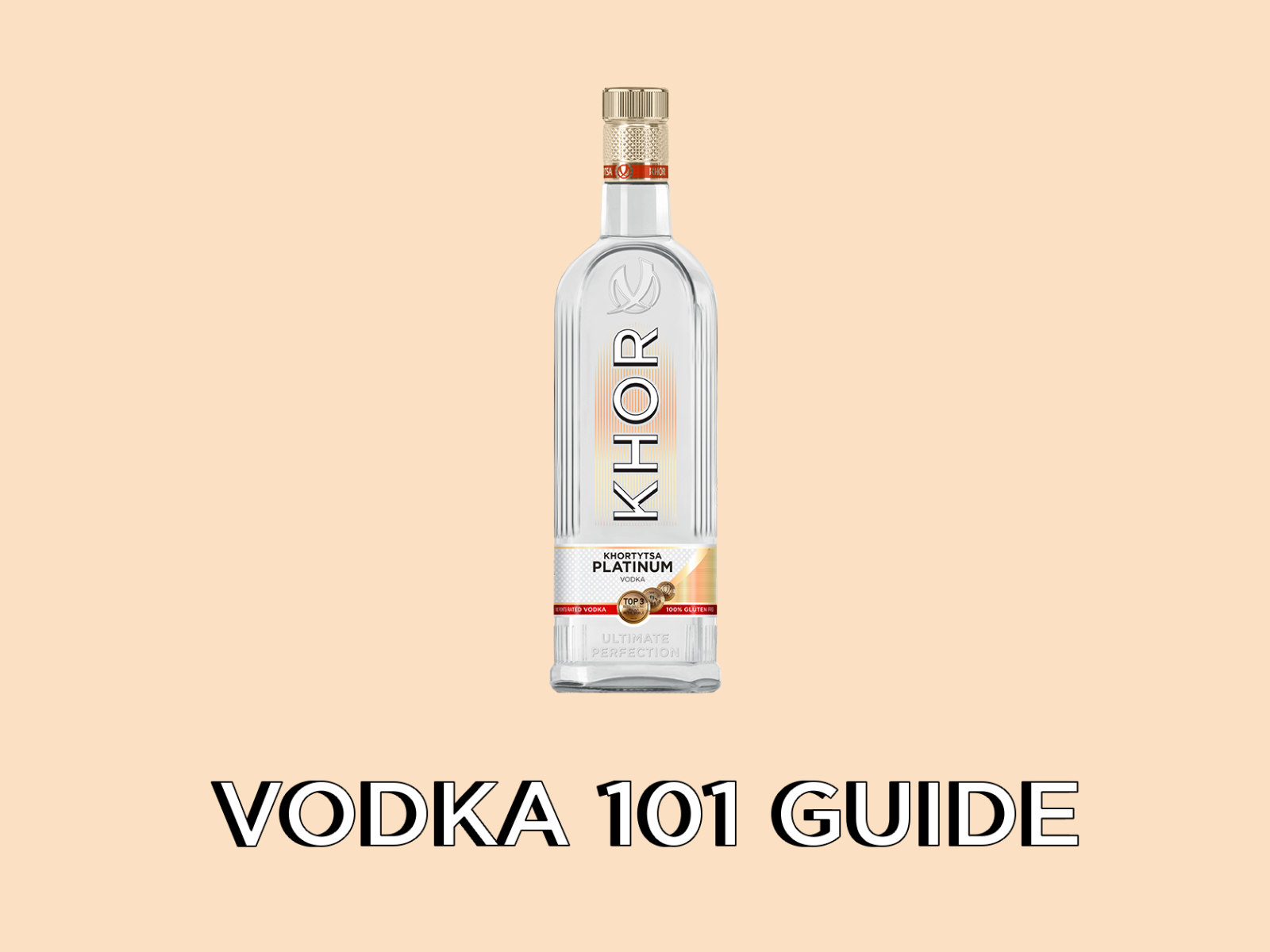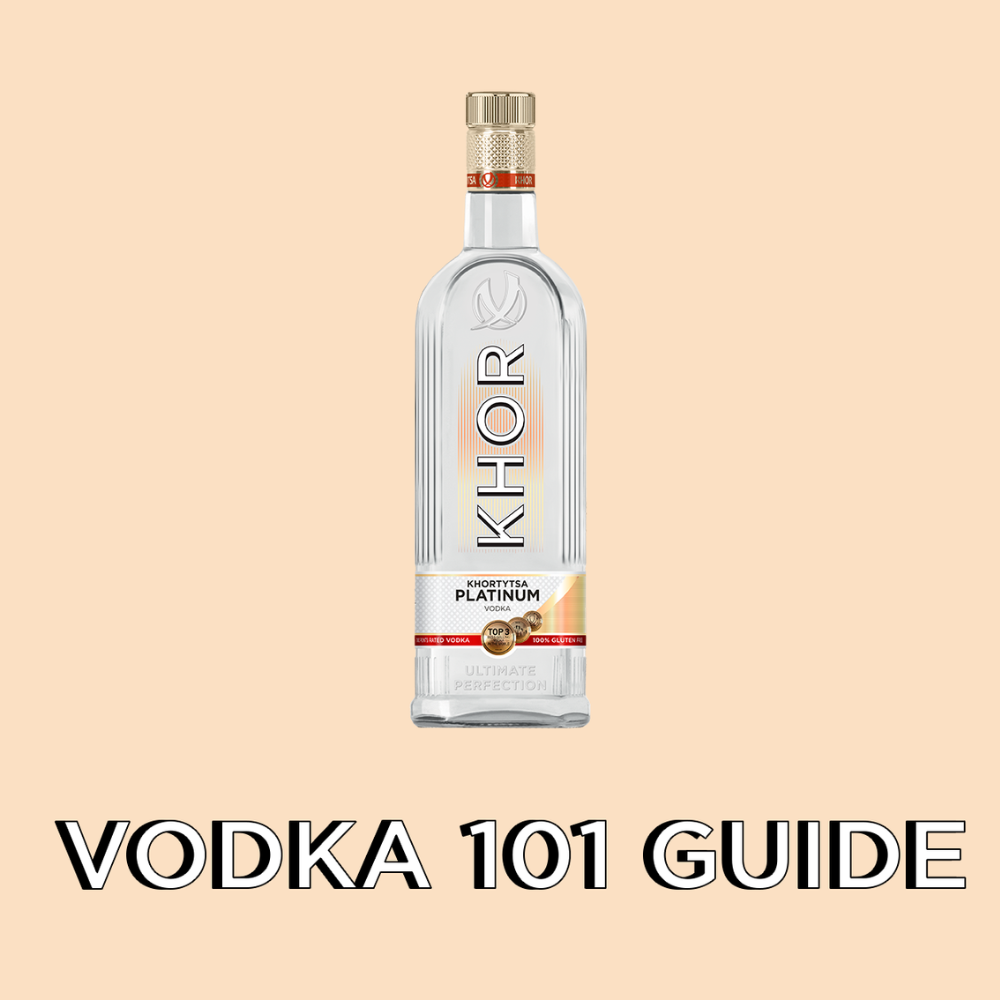The most comprehensive guide to vodka 2025
ARTICLE UPDATED: 2ND JANUARY 2025



IN THIS ARTICLE:
Introduction
- The history of vodka
- Vodka museums
- The formula and composition of vodka
- How to make vodka and what is made from
- Homemade vodka – moonshine
- The calorie content of vodka
- Vodka and snacks
- The best vodka cocktails
- Debunking myths about vodka:
Vodka doesn't freeze
Vodka lowers your blood pressure
Vodka flushes out radiation - How to drink vodka: drinking culture
- What to drink vodka from: the right tableware
The types of glasses
How to serve vodka - The correct temperature for vodka
- Vodka brands and popularity rankings
For much of Western history, vodka was called "aqua vitae", which in Latin translates to "water of life". Even today, hints of this traditional name can be found in the Scandinavian language drink aquavit (Akevitt in Norwegian, Akavit in Danish), which is the national alcohol with a strength of 37.5-50%. The Polish "okowita" and Ukrainian "оковита" (okovita) are also derived from this name. The term "vodka" appeared at the end of the 19th century and is a slight variation of the Latin "aqua," meaning water.

Until the end of the 19th century the drink had various names depending on the methods and materials used in the distillation process: hot wine, mead (if honey was used), kvass (if rye was used) and beer (if barley and hops were used).
The Polish and Ukrainian variants of the word "vodka" date all the way back to the Kievan Rus term, "hot wine" (wine that burns): resulting in the Polish "gorzalka" and Ukrainian "горілка" (gorilka).
1. The history of vodka: how it all started

Painting by K.E. Makovsky "Kissing rite" (Feast at the boyar Morozov)
The flammable nature of wine vapors was well-known among ancient philosophers and scholars, including Aristotle and Theophrastus. According to Russian Wikipedia, instructions to obtain the spirit can be found as early as in the notes of the 9th-century Persian healer, alchemist and philosopher Abu Bakr al-Razi. English Wikipedia also mentions that the process of distilling wine was found in Arabic-language books supposedly written by Arab philosopher Al-Kindi, Islamic philosopher Al-Farabi, as well as Arab physician Al-Zahrawi. It's important to note that these ancient scientists and philosophers extracted the spirits for their valuable essential oils and essences.
According to the British encyclopedia Britannica, in the 1100-1200s the first ethyl spirit was extracted in Italy. In the 11th century Italian doctor Taddeo Alderotti described the method for concentrating alcohol which included fractional distillation through a water-cooled tank, a technique which could produce alcohol with a purity of 90%. This was called "spiritus vini", meaning "the spirit of wine" — the difference being that now that vodka was "distilled" as a drink.
In 1386, the Genoese ambassadors brought their aqua vitae grape from Italy to Grand Prince of Moscow Dmitri Donskoi as a diplomatic gift.
In his book "The History of Vodka", William Pokhlyobkin dates Slavic distillation back to between 1460 and 1500, with the first place of production being an orthodox monastery. At the beginning of the 16th century, hot or burning wine had already become a part of daily life.
According to the British encyclopedia Britannica, in the 1100-1200s the first ethyl spirit was extracted in Italy. In the 11th century Italian doctor Taddeo Alderotti described the method for concentrating alcohol which included fractional distillation through a water-cooled tank, a technique which could produce alcohol with a purity of 90%. This was called "spiritus vini", meaning "the spirit of wine" — the difference being that now that vodka was "distilled" as a drink.
In 1386, the Genoese ambassadors brought their aqua vitae grape from Italy to Grand Prince of Moscow Dmitri Donskoi as a diplomatic gift.
In his book "The History of Vodka", William Pokhlyobkin dates Slavic distillation back to between 1460 and 1500, with the first place of production being an orthodox monastery. At the beginning of the 16th century, hot or burning wine had already become a part of daily life.



1. "History of vodka", edition of 1991 V.V. Pokhlebkin
2. William Vasilyevich Pokhlebkin 1923-2000
3. Illustration from the book "The History of Vodka" by V.V. Pokhlebkin
2. William Vasilyevich Pokhlebkin 1923-2000
3. Illustration from the book "The History of Vodka" by V.V. Pokhlebkin
With the introduction of the Eastern European state monopoly in the second half of the 15th century, industrial distillation began to appear, i.e. the production of alcohol and vodka from sugary and starchy products. This was the first time that the state monopoly involved itself in the operations of an alcoholic drink. The state held exclusive sales rights of the vodka which was produced in private distilleries.


1. Excise stamp "State-owned wine 1/200 of a bucket. Fortress 40%" 1910s
2. Excise stamp "Bread wine 1/40 of a bucket. Fortress 40%" 1920s
2. Excise stamp "Bread wine 1/40 of a bucket. Fortress 40%" 1920s
But what about Russian chemist Dmitri Mendeleev? Was his role in the creation of vodka not important? The scientist has only been indirectly connected to the popular drink. In 1865, he defended his dissertation on the properties of an alcohol-water solution. The results of his measurements of water-alcohol solutions formed the basis of alcoholometric tables. However, the idea that Mendeleev invented vodka is simply a myth.



1. Dissertation of Mendeleev D.I. "On the combination of alcohol with water", 1865
2. Dmitry Ivanovich Mendeleev in his office in the Main Chamber of Weights and Measures
3. Scientific work of Mendeleev D.I. "Study of aqueous solutions by specific gravity", 1887
2. Dmitry Ivanovich Mendeleev in his office in the Main Chamber of Weights and Measures
3. Scientific work of Mendeleev D.I. "Study of aqueous solutions by specific gravity", 1887
Whereas Europeans had already been drinking it for several centuries, the first mention of vodka in the US was in 1859 in the newspaper The New York Herald. The article written by a newspaper correspondent concerned the eccentricities of soldiers and sailors. In 1871, the Vermont Watchman and State Journal coined vodka as comparable to corn brandy.
It's worth noting that vodka was not immediately successful in America. At the time, Americans had their own alcohol preferences of bourbon, whisky, and gin. It wasn't until several decades had passed, and Prohibition, a period with strict alcohol bans and restrictions, began, that lovers of strong drinks picked up on the colourless vodka, since it was intoxicating and undetectable in a glass. In 1934 the first vodka distillery opened in Connecticut.
It's worth noting that vodka was not immediately successful in America. At the time, Americans had their own alcohol preferences of bourbon, whisky, and gin. It wasn't until several decades had passed, and Prohibition, a period with strict alcohol bans and restrictions, began, that lovers of strong drinks picked up on the colourless vodka, since it was intoxicating and undetectable in a glass. In 1934 the first vodka distillery opened in Connecticut.

First vodka distillery opened in Connecticut
Americans have always loved a strong "colored" drink – such as whisky and bourbon – which are aged in special oak barrels. Gin, which is colourless, was also a common ingredient used in cocktails. Much like gin, vodka started to gain popularity in the US thanks to its ideal pairing with juices and other alcoholic beverages: a Screwdriver combines vodka with orange juice; a Bloody Mary combines vodka with tomato juice; an Ice Pick combines vodka and cold tea; and a Bull Shot combines vodka and hot spicy beef broth.
According to sales from 1976, vodka had become more popular than scotch and even came close to beating bourbon. This was an absolute triumph and the drink became even more popular in the 80s, when an Absolut vodka ad featuring American artist Andy Warhol appeared on TV, followed by the appearance of a new combination of drinks – vodka and energy drinks. Even today, vodka remains one of the best-selling spirits in the US with National Vodka Day, on the 4th of October, having been celebrated since 2009.
According to sales from 1976, vodka had become more popular than scotch and even came close to beating bourbon. This was an absolute triumph and the drink became even more popular in the 80s, when an Absolut vodka ad featuring American artist Andy Warhol appeared on TV, followed by the appearance of a new combination of drinks – vodka and energy drinks. Even today, vodka remains one of the best-selling spirits in the US with National Vodka Day, on the 4th of October, having been celebrated since 2009.
2. Vodka museums
There are a number of well-known vodka museums around Western and Eastern Europe and America, featuring impressive exhibitions of the alcohol. Many brands have their own museums at the distilleries.
The Museum of Spirits is one of the world's largest museums of alcohol and is located on the island of Djurgården in Stockholm, Sweden. The exhibition includes wine samples and the history of alcohol in Sweden, as well as historical documents detailingwith detailed description of vodka production in the country the production of vodka in the country. It also features exhibitions of the country's most famous vodka brand – Absolut, which is produced by the company V&S Group, although the brand is owned by the French company Pernod Ricard.
The Museum of Spirits is one of the world's largest museums of alcohol and is located on the island of Djurgården in Stockholm, Sweden. The exhibition includes wine samples and the history of alcohol in Sweden, as well as historical documents detailingwith detailed description of vodka production in the country the production of vodka in the country. It also features exhibitions of the country's most famous vodka brand – Absolut, which is produced by the company V&S Group, although the brand is owned by the French company Pernod Ricard.


In America, the Museum of the American Cocktail, founded by pioneer of the craft cocktail Dale DeGroff, houses a collection of more than 1000 different vodkas.



The Polish Vodka Museum in Warsaw opened in 2018, and is the newest vodka museum. It, that is located in the Polish capital on the site of a former vodka distillery, where the famous "Wyborowa" and "Luksusowa" recipes were created in the 20th century. It is a modern museum with a multimedia exhibition whose logo and design comes from the result of a national competition. Throughout the exhibition, one can discover the history of the first polish liquor distillery, and also traditional Polish vodka customs and habits associated with the consumption of the drink.


The Polish Vodka Museum in Warsaw
3. The formula and composition of vodka
C2H5OH 40 % + H2O 60 % is the chemical composition of vodka. The traditional ratio of alcohol to water was the result of experiments and several bureaucratic agreements.
Originally, before the invention of alcohol metrics, the strength of a drink was measured by the process of annealing. Remember the original name for vodka, "hot wine"? Vodka-makers simply set the wine alight and when half of the drink's volume burnt away, the strength of the drink was a so-called "half bar" or 38% alcohol.
The "half bar" remained the standard strength for vodka for a long time. However, the number wasn't particularly convenient for calculations, so it was suggested that the number be rounded up. At the end of the 19th century, this new standard of 40% alcohol was set in official documents.
Originally, before the invention of alcohol metrics, the strength of a drink was measured by the process of annealing. Remember the original name for vodka, "hot wine"? Vodka-makers simply set the wine alight and when half of the drink's volume burnt away, the strength of the drink was a so-called "half bar" or 38% alcohol.
The "half bar" remained the standard strength for vodka for a long time. However, the number wasn't particularly convenient for calculations, so it was suggested that the number be rounded up. At the end of the 19th century, this new standard of 40% alcohol was set in official documents.

The annealer of the beginning of the 19th century, from the book by Ivan Zakharov "The owner of the distiller, revealing information related to the establishment of wineries and the production of distillation", 1880
In the 1940s, Soviet officials adopted a state standard according to which vodka was a drink to be made from ethyl spirit and water with a strength of 40% alcohol. In several countries, this standard is still in place; according to broader European standards, vodka can also have a strength of 37.5%. These standards specify a nominal amount of alkali and a set concentration of esters, fusel oils, and acetaldehyde.
American vodkas became popularised in the 90s and are largely similar to European vodka in terms of composition.
American vodkas became popularised in the 90s and are largely similar to European vodka in terms of composition.
4. How vodka is made and what is it made from
The process of making vodka is rather straightforward: a rectified spirit, or a spirit free of impurities, is diluted using purified water. However, each distillery has its secrets and tricks. Unlike whisky, cognac, or other strong drinks, vodka is a rectified rather than distilled spirit. Therefore, because its composition is simply spirit and water, vodka, is considered a more "pure" drink compared to other alcoholic beverages.
Unlike cognac from the French department of Charente, or champagne, a wine from the Champagne province, vodka cannot be traced back to a singular location of origin. Furthermore, many countries around the world have their own vodkas so it is not possible to describe a singular general method by which the drink is produced: it varies depending on traditions and country laws. We can, however, point out some common features.
Unlike cognac from the French department of Charente, or champagne, a wine from the Champagne province, vodka cannot be traced back to a singular location of origin. Furthermore, many countries around the world have their own vodkas so it is not possible to describe a singular general method by which the drink is produced: it varies depending on traditions and country laws. We can, however, point out some common features.
Vodka is an alcoholic drink with a strength between 37.5% and 56% alcohol and is made by processing the water-spirit solution with special sorbents and non-volatile components.
All vodkas share certain similar characteristics:
All vodka can be roughly divided into two main groups: classic and special.
Special vodka differs from classic vodka in that it contains aromatic spirits. Vodkas that are infused with herbs, spices, berries, or fruits are considered infused vodkas. Aromatic alcohol is the product of distilling an alcohol infusion with some type of ingredient, such as spicy herbs (cinnamon, mint, oregano etc.). The essential oil raw materials are distilled from the alcohol infusion with these herbs, which is then added to vodka.
- The base of vodka is commonly a spirit made from grains or potato, and is graded according to its purity: basic, extra, luxe, or alpha.
- The water used for vodka is typically taken from natural sources.
- The filter elements for vodka may include coal, special sand, silver, or even precious stones that have been ground up.
All vodka can be roughly divided into two main groups: classic and special.
Special vodka differs from classic vodka in that it contains aromatic spirits. Vodkas that are infused with herbs, spices, berries, or fruits are considered infused vodkas. Aromatic alcohol is the product of distilling an alcohol infusion with some type of ingredient, such as spicy herbs (cinnamon, mint, oregano etc.). The essential oil raw materials are distilled from the alcohol infusion with these herbs, which is then added to vodka.
5. Homemade vodka – Moonshine
This is where creativity begins. Homemade vodka, better known as moonshine, has many variations and just as many recipes.
Making the fermented braga drink involves water, yeast, and a product with high sugar content. Sometimes, the sugar product is added separately. The traditional ingredients for making braga include the following:
Making the fermented braga drink involves water, yeast, and a product with high sugar content. Sometimes, the sugar product is added separately. The traditional ingredients for making braga include the following:
- Grape juice or grape pomace — what is left after squeezing the grape;
- Fresh fruit or dried fruit;
- Jam;
- Honey;
- Fruit-filled sweets;
- Common and sprouted wheat;
- Rice malt;
- Barley;
- Corn cob with wheat flour;
- Rye bread with boiled potatoes.

How to make moonshine
1
Method
To start, make the wort – a liquid that contains sugar. Next, combine the water, yeast and, sugar products (or simply sugar) into a special container.
2
Fermentation
During the fermentation process, the wort and yeast mixture is sealed in an air-tight container and kept under strict environmental conditions. Common standards include a steady temperature under 98° F and a location away from the sun or anything else that could cause temperature change. The container must also have a place for the carbon dioxide byproduct to escape.
3
Distilling
After the yeast has completely processed the sugar, you will be left with a braga that contains ethyl spirit and other impurities. Alcohol is a waste product of yeast. After 3 days, you will have the end product after one or more rounds of distillation.

Distillery of moonshine in Brenham, Texas 1930s
Distillation is carried out using a distillation apparatus: the braga is heated up, the alcohol evaporates, passes through a cooling tube, turns back into a liquid, and flows into a container. There are many different homemade versions of this apparatus.
However, moonshine and vodka are actually different products. Moonshine is made using distillation, which leaves a dangerous amount of impurities unremoved. Therefore, we do not recommend attempting to produce or consuming it. On the other hand, the alcohol used for vodka is purified using rectification, which does fusel oils and acetaldehyde from the end product.
Moonshine is banned in America, but that does not mean that it is any less popular. The centre of American moonshine production lies in the west and south-east of the country. Under federal law, homebrewing is a crime in 17 states and is punishable by fine.
However, moonshine and vodka are actually different products. Moonshine is made using distillation, which leaves a dangerous amount of impurities unremoved. Therefore, we do not recommend attempting to produce or consuming it. On the other hand, the alcohol used for vodka is purified using rectification, which does fusel oils and acetaldehyde from the end product.
Moonshine is banned in America, but that does not mean that it is any less popular. The centre of American moonshine production lies in the west and south-east of the country. Under federal law, homebrewing is a crime in 17 states and is punishable by fine.
6. The calorie content of vodka
Vodka has a significant energy value, measured in kcal. It also has almost no nutritional value as it contains no protein, fat or carbohydrates.
The average calorie content of vodka is 235 calories per 100 grams, but there is a difference between vodkas of the lowest and highest extremes: 220 calories and 255 calories. The relatively low overall energy value of the alcohol is due to the multiple filtration rounds and the large amounts of water used for its production. It is worth noting that when other ingredients are added to the drink, such as glucose, its calorie content increases.
Generally speaking, vodka has a higher calorie content than wine or beer, but is 1.5x lower than that of liquor.
In terms of calories, vodka is similar to bread and meat, but is less detrimental to the amount of muscle fat. The consumption of ethanol spirits still slows down the process of breaking down fats, which generally slows down fat metabolism.
If you are watching your waistline, vodka could be a good choice for alcohol as it is low in calories and contains virtually no carbohydrates.
The average calorie content of vodka is 235 calories per 100 grams, but there is a difference between vodkas of the lowest and highest extremes: 220 calories and 255 calories. The relatively low overall energy value of the alcohol is due to the multiple filtration rounds and the large amounts of water used for its production. It is worth noting that when other ingredients are added to the drink, such as glucose, its calorie content increases.
Generally speaking, vodka has a higher calorie content than wine or beer, but is 1.5x lower than that of liquor.
In terms of calories, vodka is similar to bread and meat, but is less detrimental to the amount of muscle fat. The consumption of ethanol spirits still slows down the process of breaking down fats, which generally slows down fat metabolism.
If you are watching your waistline, vodka could be a good choice for alcohol as it is low in calories and contains virtually no carbohydrates.

7. Vodka and snacks
In Slavic culture, it is customary to drink vodka around a meal. You can drink vodka 30 minutes before lunch or dinner as an aperitif to increase appetite, and as a digestive drink immediately after the main meal.
In America and Europe, vodka is more popular as a cocktail base. In Europe, vodka is also drunk alongside light snacks such as olives, oysters, caviar, and finger sandwiches.
In America and Europe, vodka is more popular as a cocktail base. In Europe, vodka is also drunk alongside light snacks such as olives, oysters, caviar, and finger sandwiches.
There is a standard set of vodka snacks on many restaurant menus:
- Cold and hot snacks: rye bread, pig fat (salo), sandwiches and canapés, pancakes with salty fillings, hearty and light salads, fresh vegetables with herbs, meat jelly (kholodets), cured meat, smoked fish, caviar, herring with onion and herbs, pickled vegetables, and mushrooms.
- Main dishes: any type of cooked meat or fish, sausages, potatoes, rich soups and dumplings stuffed with meat, fish, or vegetables.
8. The best vodka cocktails
According to urban legend, in 1921 at one of the most famous Parisian bars Harry's New York Bar, the "Bloody Mary" cocktail was invented. It is unknown exactly who invented the drink made from tomato juice and vodka – either George Jessel, an American singer, actor and film producer, or the barman Fernand "Pete" Petiot who worked in the bar.
Later on, that very same bartender emigrated to New York and got hired at the Saint Regis Hotel. The manager was not a fan of Petiot's new cocktail, and so the barman tweaked his recipe to create the drink we now know today by adding lemon juice, pepper, Worcester sauce, and ice. The celery stalk garnish wasn't added to the drink until the 60s.
In the 60s, a series of films about secret agent 007 James Bond were released, in which Sean Connery ordered his signature Vesper cocktail "shaken, not stirred." This publicity stunt, during the time of the Cold War, was politically motivated. Americans watched as the enemy of the Soviet Unionordered a martini using Smirnoff vodka – rendering the alcohol a global and not Russian drink. As a result, even the most patriotic Americans considered vodka to be theirs.
In 1998, the cult TV show series Sex and the City was released. The main characters live in New York and go out to drink their favourite cocktail, a cosmopolitan made from vodka, triple sec, lemon juice, and cranberry juice. In 2021 the show had a reboot called And Just Like That, giving the already classic "cosmo" a new lease of life.
Read also: Vodka Market 2025 Forecasts and Trends
Later on, that very same bartender emigrated to New York and got hired at the Saint Regis Hotel. The manager was not a fan of Petiot's new cocktail, and so the barman tweaked his recipe to create the drink we now know today by adding lemon juice, pepper, Worcester sauce, and ice. The celery stalk garnish wasn't added to the drink until the 60s.
In the 60s, a series of films about secret agent 007 James Bond were released, in which Sean Connery ordered his signature Vesper cocktail "shaken, not stirred." This publicity stunt, during the time of the Cold War, was politically motivated. Americans watched as the enemy of the Soviet Unionordered a martini using Smirnoff vodka – rendering the alcohol a global and not Russian drink. As a result, even the most patriotic Americans considered vodka to be theirs.
In 1998, the cult TV show series Sex and the City was released. The main characters live in New York and go out to drink their favourite cocktail, a cosmopolitan made from vodka, triple sec, lemon juice, and cranberry juice. In 2021 the show had a reboot called And Just Like That, giving the already classic "cosmo" a new lease of life.
Read also: Vodka Market 2025 Forecasts and Trends



1 and 2 - frames from the James Bond movies "Doctor No" in 1963 and "Casino Royale" in 2006 with a Vesper cocktail.
3 - frame from the series "Sex and the City" in 2002 with a Cosmopolitan cocktail.
3 - frame from the series "Sex and the City" in 2002 with a Cosmopolitan cocktail.
Top 5 vodka cocktails
-
 ScrewdriverIngredients: vodka and orange juice.
ScrewdriverIngredients: vodka and orange juice. -
 Bloody MaryIngredients: vodka, tomato juice, Worcester sauce, and spices.
Bloody MaryIngredients: vodka, tomato juice, Worcester sauce, and spices. -
 СosmopolitanIngredients: vodka, cranberry juice, lime juice, and triple sec.
СosmopolitanIngredients: vodka, cranberry juice, lime juice, and triple sec. -
 Sex on the beachIngredients: vodka, peach schnapps, orange juice, and cranberry juice.
Sex on the beachIngredients: vodka, peach schnapps, orange juice, and cranberry juice. -
 Moscow muleIngredients: vodka, ginger beer, and lime juice.
Moscow muleIngredients: vodka, ginger beer, and lime juice.
9. Debunking vodka myths
The centuries-old ethanol drink, "aqua vitae," hot wine or vodka, has resulted in many customs, proverbs, and sayings. But there are also many myths not based in science associated with the drink.
Myth 1: Vodka doesn't freeze
It's important to remember that you shouldn't freeze vodka, and that the optimal temperature for consumption is around 53.6 - 57.2°F. If vodka is too cold, it will lose its aroma and flavour, especially if it is a special vodka.
The tradition of storing vodka in the freezer is believed by many to be a way to test for the quality of the vodka: the quicker it freezes, the lower its quality. However, this isn't true. This method of checking for vodka quality is outdated and unreliable. Let's find out why.
The tradition of storing vodka in the freezer is believed by many to be a way to test for the quality of the vodka: the quicker it freezes, the lower its quality. However, this isn't true. This method of checking for vodka quality is outdated and unreliable. Let's find out why.

Factors for freezing vodka
-
 1. Freezer temperatureThe lower the temperature of the freezer, the faster the vodka will freeze. However, different freezers have different temperatures. Before experimenting with freezing vodka it is worth finding out the exact temperature controls and limits of your specific freezer model.
1. Freezer temperatureThe lower the temperature of the freezer, the faster the vodka will freeze. However, different freezers have different temperatures. Before experimenting with freezing vodka it is worth finding out the exact temperature controls and limits of your specific freezer model. -
 2. Vodka strengthThe more ethanol there is in the alcohol, the slower it will freeze: a drink that is 37% alcohol will freeze faster than one that is 42% alcohol. If it is a classic vodka with 40% alcohol content, then it will need to be between -13 - 22°F to freeze. Vodkas with additional ingredients will need even lower temperatures to freeze than those without.
2. Vodka strengthThe more ethanol there is in the alcohol, the slower it will freeze: a drink that is 37% alcohol will freeze faster than one that is 42% alcohol. If it is a classic vodka with 40% alcohol content, then it will need to be between -13 - 22°F to freeze. Vodkas with additional ingredients will need even lower temperatures to freeze than those without. -
 3. Water for making vodkaIf the distillery uses "dead" water, meaning that it is completely purified technical water, then it will significantly slow down the freezing process. While its production cost will be lower, its taste and quality will be worse. KHOR vodka is made using only natural purified water. Typically this type of water contains salts and microelements that become crystallised centres, meaning that this is where the freezing begins. For vodkas made with purified water the freezing process happens a little faster and more unevenly, and the vodka has more organoleptic properties.
3. Water for making vodkaIf the distillery uses "dead" water, meaning that it is completely purified technical water, then it will significantly slow down the freezing process. While its production cost will be lower, its taste and quality will be worse. KHOR vodka is made using only natural purified water. Typically this type of water contains salts and microelements that become crystallised centres, meaning that this is where the freezing begins. For vodkas made with purified water the freezing process happens a little faster and more unevenly, and the vodka has more organoleptic properties. -
 4. Synthetic additivesSome cunning distilleries add a synthetic glycerin to the vodka to take advantage of consumers who believe vodka doesn't freeze. This synthetic additive prevents the vodka from freezing even at extremely negative temperatures and can be detrimental to your health. Synthetic glycerin, which is different from natural glycerin, is only to be used for technical purposes. The KHOR distillery doesn't use any unnatural additives in vodka production.
4. Synthetic additivesSome cunning distilleries add a synthetic glycerin to the vodka to take advantage of consumers who believe vodka doesn't freeze. This synthetic additive prevents the vodka from freezing even at extremely negative temperatures and can be detrimental to your health. Synthetic glycerin, which is different from natural glycerin, is only to be used for technical purposes. The KHOR distillery doesn't use any unnatural additives in vodka production.
Conclusion: it is normal for vodka to freeze, as long as it does so under the right conditions. Whether or not vodka freezes is not a measure of its quality.
Myth 2: Vodka lowers your blood pressure
30 - 50ml of vodka can temporarily lower blood pressure and improve vascular tone. This is because blood vessels will expand under the influence of alcohol, and blood flow will increase as the load on the vascular walls decreases. But all of this lasts no longer than 30 minutes before the blood vessels constrict and blood pressure rises sharply. The increased blood flow to the heart causes the heart to contract intensively, which raises both your pulse and blood pressure. This cycle increases with every drink consumed.

Vodka can both lower and raise blood pressure. It all depends on the amount consumed and individual factors such as age, physical health, and eating and drinking habits.
Myth 3: Vodka flushes out radiation
There is still one myth left, which came about in 1986 after the Chernobyl nuclear reactor incident. Following this disaster, the entire world sought remedies for nuclear radiation, and vodka was even considered as a possibility.
Alcohol is indeed a solvent, meaning that when it enters a person who has been infected by radiation's body, it "washes away" and evenly distributes radionuclides throughout the blood vessels. Even if these radionuclides were originally collected in the spinal cord, lymph nodes, lungs or thyroid gland, they will disperse throughout and affect the inflicted individual's entire body once vodka has been drunk.
The reason why some believe that vodka has anti radiation properties appears to be because it slows down the movement of oxygen molecules.
Alcohol is indeed a solvent, meaning that when it enters a person who has been infected by radiation's body, it "washes away" and evenly distributes radionuclides throughout the blood vessels. Even if these radionuclides were originally collected in the spinal cord, lymph nodes, lungs or thyroid gland, they will disperse throughout and affect the inflicted individual's entire body once vodka has been drunk.
The reason why some believe that vodka has anti radiation properties appears to be because it slows down the movement of oxygen molecules.

These molecules are what "carry"radiation. However, you can only slow radionuclides down entirely by drinking astronomical amounts of alcohol — levels which at that point are detrimental to your health.
Vodka does not eliminate radionuclides.
10. How to drink vodka: drinking culture
In order to properly experience the taste of vodka, it is preferable to drink at least two small sips. It is also improper to throw your head back and grimace after drinking strong alcohol.
According to European etiquette during formal events, the host or waiter should fill the glass with vodka and stand to the right behind the guest.
During informal events without hosts or waiters, it is considered polite to first pour the vodka for the guests and then for yourself. It is bad etiquette to only fill your own glass.
According to European etiquette during formal events, the host or waiter should fill the glass with vodka and stand to the right behind the guest.
During informal events without hosts or waiters, it is considered polite to first pour the vodka for the guests and then for yourself. It is bad etiquette to only fill your own glass.

11. What to drink vodka from: the right tableware
The proper tableware for serving vodka differs according to several categories:
- Material: regular glass, crystal, stainless steel, and silver;
- Capacity: 25-100 milliliters;
- Shape: stemmed glasses, vodka glasses, shot glasses, faceted glasses, decanters, and bottles;
- Design: transparent with faceted sides, silver, colored or gold decorations, thin or thick bases for stability.
Types of vodka glasses
- Classic vodka glassesMade out of regular glass or crystal, the classic vodka glass is a cylindrical container with straight or faceted walls and a standard volume capacity of 50 milliliters — or in the case of a "double" shot 100 milliliters.
- Travel vodka glassesThe shape of travel vodka glasses are similar to regular vodka glasses, but they are made out of metal, typically either food grade stainless steel or silver.
- ShotsThese vodka glasses holding at least 20 milliliters are often simply referred to as shot glasses. These are is designed for the user to quickly drink vodka and strong alcoholic cocktails in one gulp or one "shot."
- Penalty vodka glassesPenalty vodka glasses feature peculiar bases that are unstable with a metal figure, for example carved in the shape of a person or a bear's head. They are not set on the table but rather filled and drunk immediately.
- Stemmed glassesThis is a miniature glass that can hold 40 - 100 milliliters. The glass is particular because it has an elegantly long stem shape and a round base to provide it stability. Stemmed glasses are used for pouring neat vodka and strong infusions.
- Faceted glassContrary to the strong association between faceted glass, vodka, and the Soviet Union, these types of glass containers were produced as far back as 1713 for sailors. Thanks to their facets and wide bases, these glasses were stable when out at sea and didn't break as often as round glasses.
Faceted glass began to be mass-produced in the 1860s. In 1943, the first set of the famous 16-sided glasses were made, with each of the facets symbolising one of the Soviet Republics. They hold anywhere between 200 milliliters, if up to the rim, and 250 milliliters, ifup to the edge. There are also smaller versions of the faceted glass such as the 100 milliliters vodka glass.
The world's smallest stemmed glass is called "the fly" and holds 10-15 milliliters, or one tablespoon, of liquid.
Interestingly, the Russian expression "to walk on a fly" (the English equivalent would be "on the fly") came about from the smallest stemmed glass in the world. Its small size – holding 10-15 milliliters or the equivalent of one tablespoon – earned it its name.
The appearance of "the fly" is connected to Emperor Tsar Peter I's decision to popularise taverns, where unlike inns, people could not only drink, but also eat.
In a bid to attract customers, tavern owners would offer the first glass for free. However, to save money and remain profitable, they offered resulting drinks in these small glasses.
The appearance of "the fly" is connected to Emperor Tsar Peter I's decision to popularise taverns, where unlike inns, people could not only drink, but also eat.
In a bid to attract customers, tavern owners would offer the first glass for free. However, to save money and remain profitable, they offered resulting drinks in these small glasses.

Glass "Elabuga fly", the beginning of the XVIII century
Yelabuga State Historical, Architectural and Art Museum-Reserve
Yelabuga State Historical, Architectural and Art Museum-Reserve
How to serve vodka
- The original distillery bottleThe most common way to pour vodka is from the distillery's bottle. This is practical because firstly it eliminates any preparation time, secondly not everyone has a decanter or bottle at hand, and thirdly because vodka is best stored and kept cool in its original bottle.
- A decanterA decanter is an Arabic container that is typically made from crystal and that has a high top and a wide rounded base. It is easy to pour liquid from the decanter into a glass because of the thin handle and spout. It is designed to serve a maximum of 6 people and holds 500 - 1000 milliliters. It is customary to present a decanter with a set of vodka glasses or stemmed glasses on a special tray.
- A shtoffThis is a 4-sided glass container that has a square cross-section and a short neck to prevent the drink from evaporating quickly. Bottles originate from Kievan Rus where they were used to measure the volume of alcoholic drinks. The following is a standard measurement system the shtoff came to represent: 10-piece shtoff - 1.23 liter or 1/10 of a bucket, the equivalent of 10 cups; 8-piece shtoff - 1.54 liter or approximately two bottles of vodka. The volume of a modern-day shtoff is 800-1500 milliliters, with a half shtoff holding 400-760 milliliters.
Both decanters and bottles are now used exclusively in some Eastern European countries. In the majority of European countries and in the US, they are not normally used. Instead, vodka is poured straight from the distillery's bottle into stemmed glasses.
12. The correct temperature for vodka
The idea that vodka kept colder before serving is more tasty isn't entirely correct. The habit of keeping vodka extremely cold, or even freezing it, has appeared for several reasons.
Part of this idea, emerged from the desire to keep the drink at a low temperature to hide possible impurities, hence allowing unassuming drinkers to consume more of it.
Professional vodka tasters state that the ideal temperature to serve vodka at is 53.6 - 57.2°F. The vodka's organoleptic properties at this temperature are optimal, translating into perfect taste, aroma, and feel both during and after drinking.
Part of this idea, emerged from the desire to keep the drink at a low temperature to hide possible impurities, hence allowing unassuming drinkers to consume more of it.
Professional vodka tasters state that the ideal temperature to serve vodka at is 53.6 - 57.2°F. The vodka's organoleptic properties at this temperature are optimal, translating into perfect taste, aroma, and feel both during and after drinking.

It is not recommended to store vodka in the freezer for an extended period of time. If the drink freezes near the sides of the bottle, the non-frozen middle will be where the alcohol concentrates, leading to a pure alcohol content of significantly higher than 40%. This is because the freezing point of alcohol is lower than that of water (-173.2°F rather than 30.2°F), meaning that water freezes quicker than alcohol. If you don't wait until the water has thawed from the sides of the bottle, then you risk becoming drunk much faster than you expected. In extreme cases, you can even burn your oesophagus.
Vodka should always be refrigerated and never frozen. It is better to store the vodka in the fridge for several hours before drinking.
When serving vodka you should cool the glasses ahead of time until there is a thin layer of frost on them. This applies to the container used for serving as well, such as glass bottle or decanter.
Before pouring the vodka from a chilled bottle into a glass, you can wrap a tissue around the neck of the bottle to catch any condensation and to prevent dripping onto either the table or into the glass.
Before pouring the vodka from a chilled bottle into a glass, you can wrap a tissue around the neck of the bottle to catch any condensation and to prevent dripping onto either the table or into the glass.
13. Vodka brands and popularity ranking
The authoritative media Drinks International published the Millionaire's Club 2021 report, ranking the world's 10 best vodka brands.
- 1. SMIRNOFFDespite a large 10% drop in sales in 2020, the company which is owned by the Diageo brand, was able to hold onto its top spot.
- 2. KHOROwned by the alcohol holding Global Spirits, the brand sold 10.4 million cases of the drink in 2020, increasing sales by 6% compared to 2019. This allowed the KHOR brand to enter into the Top 2 of the world's most-sold vodkas.
- 3. ŻUBRÓWKAThe Roust-owned Polish vodka brand sold 10 million cases, increasing sales by 3% from the previous year.
- 4. ABSOLUTOwned by Pernod Ricard, the brand dropped from 2nd to 4th place after a 14% drop in sales from the previous year.
- 5. HLIBNY DARThe Ukrainian Bayadera Group-owned brand sold 8.5 million cases and increased its performance by 6% in 2020.
- 6. MOROSHAMorosha, another Ukrainian brand owned by Global Spirits holding, increased its sales by 13%. It managed to sell 7 millions cases of vodka to rise one place in ranking.
- 7. NEMIROFFAnother Ukrainian brand, which rose from 9th place to 7th, by increasing sales 19%.
- 8. SOPLICAThis vodka, owned by the Russian holding Roust, increased sales by 2% in 2020, selling a total of 4.3 million cases.
- 9. BELENKAYAThis vodka from the Beluga Group managed an increase of 11% compared to 2019 figures.
- 10. RUSSIAN STANDARDYet another vodka from Roust holding which managed a 3% increase in sales.
The ranking leaders are typically the most well-known brands. The majority of the time, these brands shift from one position to the next, or remain in the same position for a long period of time. It all depends on the specific criteria of the ranking – there are rankings for the cheapest brand and the most expensive brand, the fastest-growing brand, and the most popular brand on social media. Every ranking has its own merits and may result in slight differences from brand to brand.
How much does cost to launch your own beverage company?
If your run size is 10'000 cases, your production costs will fall somewhere between $60'000 and $110'000. Read more in the article How much does it cost to launch a beverage brand.

© 2025 GSH Trademarks Limited
Khor vodka has a standard alcohol concentration of 40% ABV
Web design, web development and digital marketing by ALCOHOL MARKETING AGENCY
Khor vodka has a standard alcohol concentration of 40% ABV
Web design, web development and digital marketing by ALCOHOL MARKETING AGENCY

